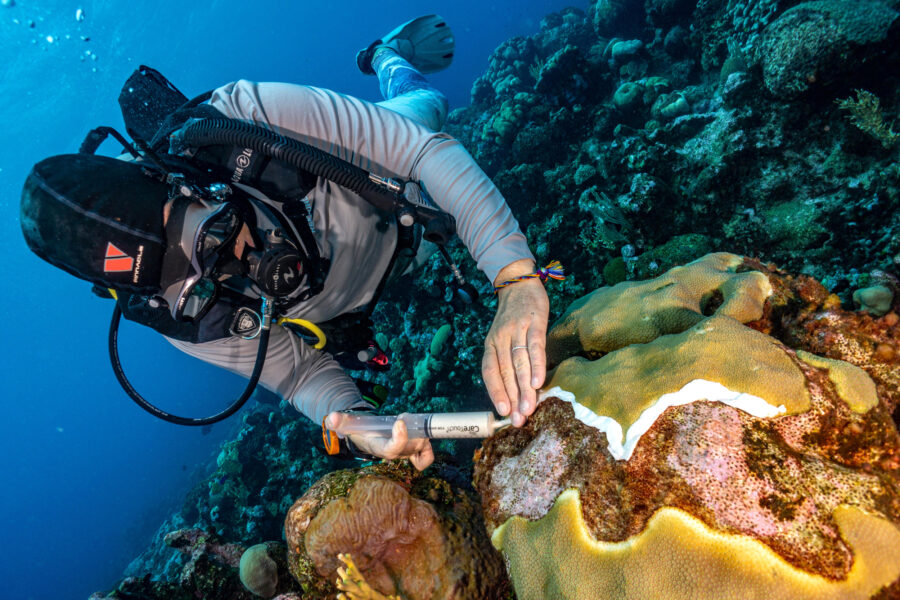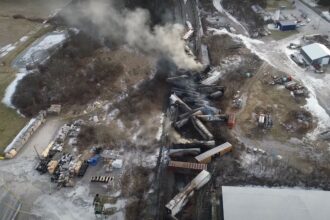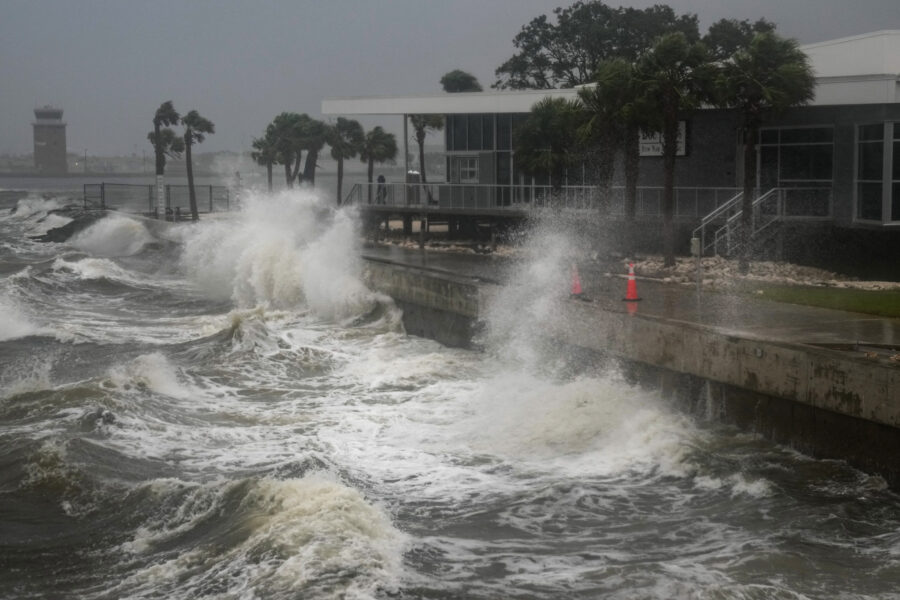Why Hurricanes Are Much—Much—Deadlier Than Official Death Counts Suggest
From our collaborating partner Living on Earth, public radio’s environmental news magazine, an interview by Paloma Beltran with Rachel Young, an environmental economist and postdoctoral researcher at the University of California, Berkeley.
Hurricane Milton spun off deadly tornadoes and cut power to more than 3 million Floridians as it charged across the Florida Peninsula. Tampa dodged the worst-case scenario of massive storm surge, but nearby St. Petersburg experienced over 17 inches of rain.
Deaths from Hurricane Milton are still being tallied; meanwhile, the official death toll from Hurricane Helene has passed 230. But as devastating as those numbers are, a recent paper published in Nature suggests that these initial death tolls probably account for a fraction of the mortality that can be linked to hurricanes.
As many as 3 million excess deaths can be attributed to tropical storms and hurricanes that impacted the U.S. between 1930 and 2015.
Explore the latest news about what’s at stake for the climate during this election season.
Lead researcher Rachel Young is an environmental economist and postdoctoral researcher at the University of California, Berkeley. This interview has been edited for length and clarity.
RACHEL YOUNG: In our paper, we studied 500 tropical storms and hurricanes, which we call tropical cyclones, that impacted the United States between 1930 and 2015, and we estimate the long-run impact those storms have had on mortality at the state level.
We found that there are persistent effects for up to 15 years, there are elevated rates of mortality for up to 15 years, and that per storm there’s between 7,000 and 11,000 excess deaths, which is 300 times greater than the official counts of direct deaths. These results really highlight that hurricanes and tropical storms are a much greater mortality burden than anyone previously thought.
BELTRAN: Why do mortality rates remain so high even after storms hit?
YOUNG: We can’t disentangle all of the different ways that hurricanes impact people’s lives that could lead to elevated rates of mortality. We do posit a few hypotheses of what could be going on in the paper. We have five. I’ll just talk through a couple, though.

The first, and I think the most prevalent, is that there are just long-run economic impacts that hurt people after these storms. You can imagine that your house is partially destroyed or damaged, and folks have to draw down from their retirement accounts or their savings accounts to pay for repairs to those damages, which may, in turn, mean that in the future, if they have a health care incident, or they need to go to the hospital for any sort of health care related reason, they might not have as much money to pay for the kind of care that they need compared to what kind of money they would have had before the storm.
Another potential channel is just that there’s massive devastation that can occur after these events, huge amounts of damage, and that could drive heightened levels of pollution exposure for individuals. So a storm comes in, it could destroy a gas station or other kinds of facilities that house a lot of chemicals. We’ve seen with Helene some impacts to the sewage systems and massive amounts of raw sewage flowing in the streets. These kinds of pollution exposures can have long-term impacts on people’s health outcomes.
And finally, state and local governments have lower budget levels after these storms. They spend a lot of money on repairs for roads and bridges and other kinds of infrastructure, which means that they don’t have as many resources to allocate to things like buying a new wing for a hospital, or other kinds of health care-related emergency services, which could impact people’s health care in the long run.
BELTRAN: How do death rates differ across age groups?
YOUNG: One thing we thought was really important is to understand if different kinds of folks are at different levels of risk after a storm. Infants and the elderly population are particularly vulnerable after a hurricane. Infants have a much greater mortality risk than, say, folks between 1 and 44. For the infant results, these are infants that are being born many years after the storm, so they did not physically experience the hurricane or tropical storm themselves.
The southeast of the United States has elevated rates of mortality compared to the rest of the country, particularly for infants, and we actually find that tropical cyclones are a major driver of those impacts. These are places and states that are getting hit by tropical cyclones many, many times, and that overall climate of being impacted by tropical cyclones is part of the reason why we’re seeing higher rates of mortality in the southeastern states.
BELTRAN: So according to this study, infants who weren’t even conceived by the time a hurricane hits are still more likely to die because of it?
YOUNG: Yes, that’s exactly what we see. Twenty-one months after the storm, these are infants that are dying that were not in utero. They did not physically experience the hurricane or tropical storms themselves. You can imagine mothers who are giving birth a few years after the storm, maybe they were paying out of their savings account for repairs to their home, replacing their car or other things that were damaged during the storm, and so they might not have as much access to different kinds of prenatal care, because they just have less money than they would have if they had not had to pay for those repairs. We think this points to maternal health care that needs to be prioritized in order to help reduce some of these infant sensitivities.
BELTRAN: How did this study account for race?
YOUNG: We are able to look at the different risk of mortality amongst the Black population compared to white populations, and we find that Black populations are much more sensitive after a storm. They have higher rates of mortality compared to their counterparts in white populations. In fact, their mortality risk is about three times greater than white populations.
There’s a lot of growing literature and discussions around the differences that Black populations face with regard to different kinds of environmental events. There’s studies that show that they experience heightened rates of air pollution because of the history of zoning and public housing in the United States. There’s a lot of other systemic reasons why Black populations have less access to federal resources after disasters, or just other kinds of public services, and we think a lot of that is tied up in why we see elevated rates of mortality risk for those populations.
BELTRAN: This study focuses on the continental U.S., but how does it resonate with, for example, Hurricane Maria, where almost 3,000 people in Puerto Rico died directly from the hurricane, which caused extensive damage to the island’s infrastructure. Some areas of the island are still recovering to this day.
YOUNG: There was a study that showed that the deaths traceable to Hurricane Maria were much greater than the official direct death counts, a lot of it driven by power outages that persisted for months after the storm. That paper really was inspiring to us, and helped show that the way that we think about direct deaths and deaths related to hurricanes might not be quite right. The study they did really lent credibility to our estimates of the longer-term impact of hurricanes on an individual’s mortality. They do a great job of tracing out some of the ways in which the hurricane impacted infrastructure, which then impacts people’s health.
BELTRAN: There are these big hurricanes and tropical storms like Hurricane Katrina, Helene and Maria, but what about smaller storms like Hurricane Debby that hit North Carolina earlier this year?
YOUNG: In our study, we studied the effects of 500 tropical storms and hurricanes. I expect that most people can’t name 500 tropical storms or hurricanes; there are a lot of these storms that are much smaller, that aren’t Category 5, that aren’t in the news as much.
What’s important about our findings is that these smaller storms are also impacting communities for a long time. They might not generate as many excess deaths because they have lower wind speeds and smaller footprints, but they are also impacting states, and they’re driving a lot of those big overall estimates that we find in the study. The 3 million excess deaths is not just from a Katrina or a Sandy, it’s from the cumulative effects of a lot of small storms and big storms over many, many years.
BELTRAN: What surprised you most from this study?
YOUNG: The whole study was very surprising to us.
When we initially started this paper, we knew things about the impact of hurricanes on the economy, and we knew things about how different kinds of environmental events impact health, particularly heat waves.
We thought that we would see elevated rates of mortality for maybe six months or a year. And when we were doing the analysis, and we saw that the effects were so long, we were really stunned. We spent many, many years trying to make sure that it wasn’t driven by some kind of statistical anomaly.
It wasn’t an error on our side or an error in the analysis, and we tried every other possible explanation for what could be going on, and ultimately we found that nothing else could explain this elevated mortality rate except for hurricanes. The whole thing was very, very surprising. If folks are stunned by the magnitude of the effects and the long-run impact of these events on human health and mortality, we were too.
BELTRAN: Hurricane Helene caused severe damage across southeastern states, and Hurricane Milton just hit Florida. What can government agencies and government officials learn from this study in order to provide the support communities need for recovery?
YOUNG: State, local and federal governments, and especially first responders, are doing really heroic work to help people after these events, to rescue folks, to help get them back on their feet, we don’t want their efforts to be in vain.
Our study really highlights that communities are being impacted far beyond the immediate aftermath of the storm, that these effects can impact them for many, many years and can lead to impacts on their health … five, 10 years later.
Our study really highlights that we can’t forget about these communities, and that we need to help them get back on their feet as quickly as possible. We need them to get their insurance payouts in a timely manner and get access to resources from the federal and state and local governments as fast as they can. We can’t just forget that this happened, and that these folks are going to be impacted for a long time.
We need to give them support and resources for longer than we previously thought, and hopefully that will ensure that we see lower mortality rates after hurricanes in the future.
About This Story
Perhaps you noticed: This story, like all the news we publish, is free to read. That’s because Inside Climate News is a 501c3 nonprofit organization. We do not charge a subscription fee, lock our news behind a paywall, or clutter our website with ads. We make our news on climate and the environment freely available to you and anyone who wants it.
That’s not all. We also share our news for free with scores of other media organizations around the country. Many of them can’t afford to do environmental journalism of their own. We’ve built bureaus from coast to coast to report local stories, collaborate with local newsrooms and co-publish articles so that this vital work is shared as widely as possible.
Two of us launched ICN in 2007. Six years later we earned a Pulitzer Prize for National Reporting, and now we run the oldest and largest dedicated climate newsroom in the nation. We tell the story in all its complexity. We hold polluters accountable. We expose environmental injustice. We debunk misinformation. We scrutinize solutions and inspire action.
Donations from readers like you fund every aspect of what we do. If you don’t already, will you support our ongoing work, our reporting on the biggest crisis facing our planet, and help us reach even more readers in more places?
Please take a moment to make a tax-deductible donation. Every one of them makes a difference.
Thank you,
David Sassoon
Founder and Publisher
Vernon Loeb
Executive Editor
Share this article
- Republish
Disclaimer: The copyright of this article belongs to the original author. Reposting this article is solely for the purpose of information dissemination and does not constitute any investment advice. If there is any infringement, please contact us immediately. We will make corrections or deletions as necessary. Thank you.








